Trim Fat, Silverskin and Shape the Meat
Here’s a more in depth article on this.
Overall just remove hard fat that won’t render, remove thin edges, and trim fat cap down to 1/4-1/2″ thick.
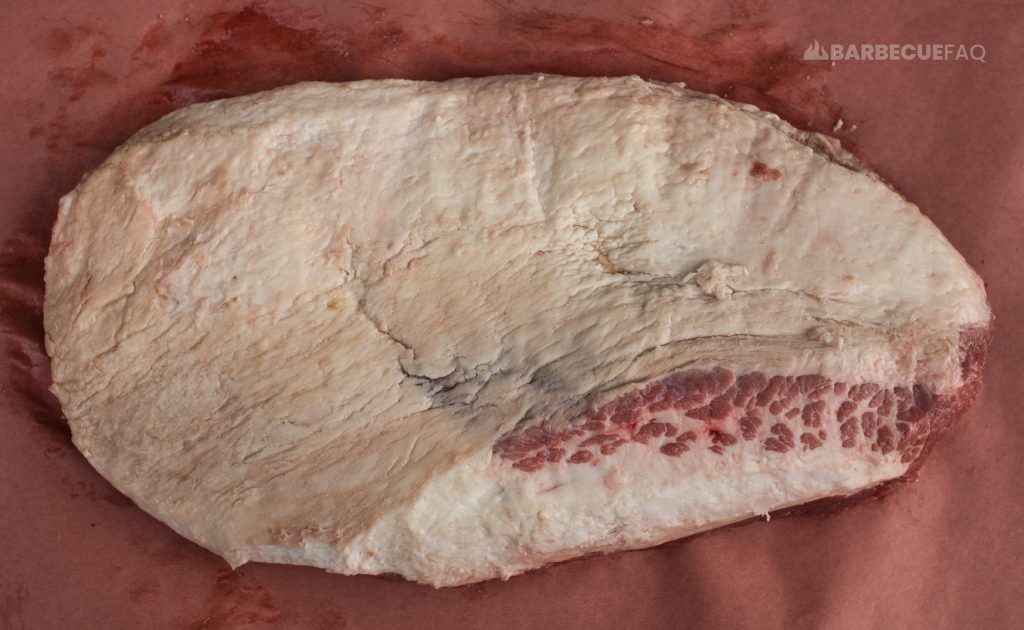
Rub Ingredients
Apply in layers to each side:
- 1 tbsp diamond crystal kosher salt
- 1 tbsp 16 mesh black pepper
- 1 tbsp seasoning salt (like Lawry’s)*
If you don’t have Lawry’s, here’s my homemade copycat.
Get Your Smoker to 225-250F
Once at temperature, add your favorite hardwood; I used post oak – replace wood every 45-60 minutes.
Point fat cap at the heat source – on my Weber kettle, that’s fat side UP.
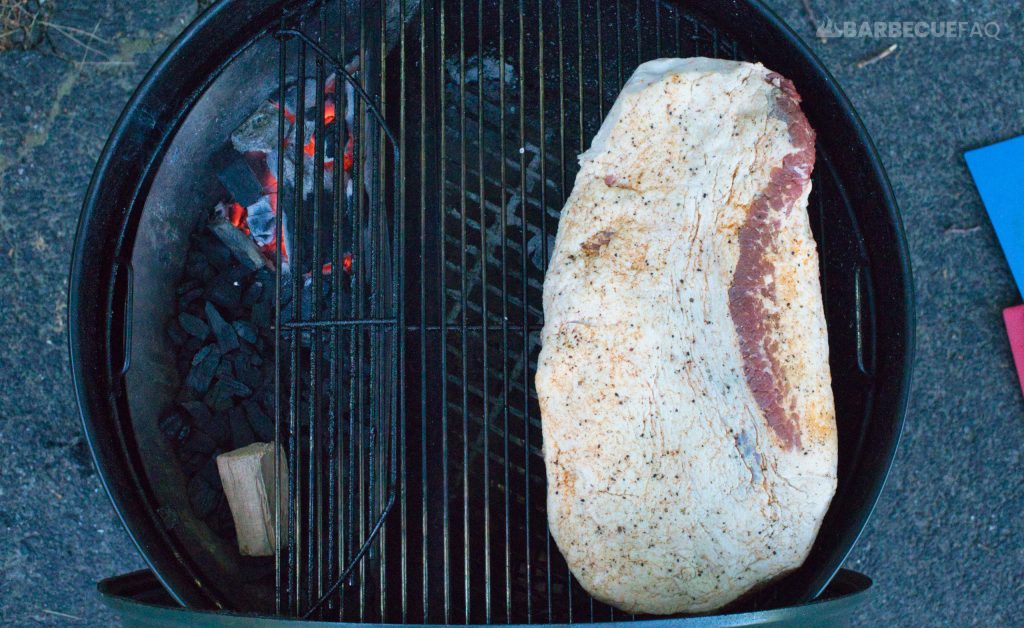
Allow Brisket to Smoke Until the Thickest Part of the Flat is ~170-180F
Going this long ensures the brisket is out of the stall.
If you foil boat during the stall (between 150-165F), you’ll collect too much liquid in the boat and the meat will end up tasting more pot-roasty than if you had waited for more moisture to sweat out.
At 170-180F the pellicle on the bark will be set and less moisture will accumulate – the surface will be matte, not wet.
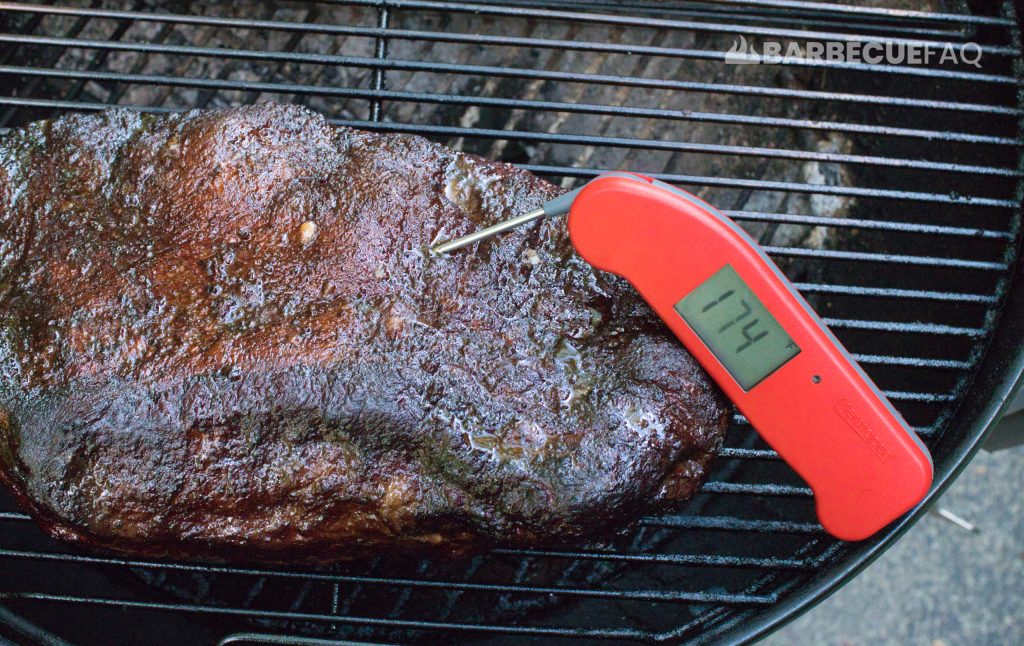
Take 2 Sheets of Arms-length, Aluminum Foil
Put the brisket fat side up in the center of the foil and then crumple the foil around the edges of the brisket, leaving the fat cap exposed.
Return to the smoker or to your oven set to 250F.
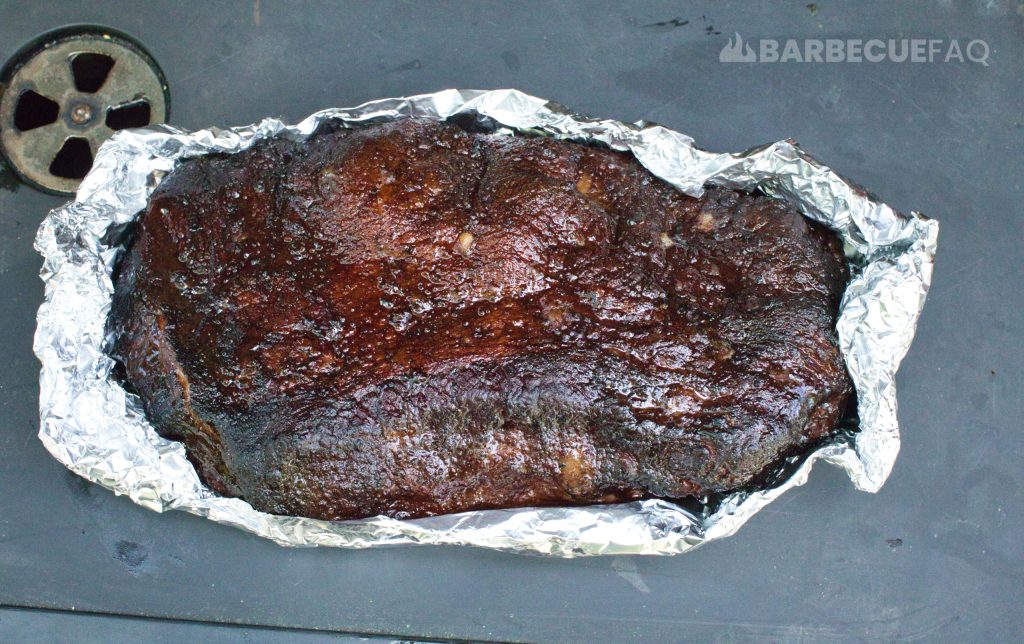
From Here You Have 2 Options
If you plan to eat the same day, smoke to probe tenderness (~195-205F) throughout the entire brisket.
Then put into your kitchen oven to rest down to 150-160F internal and then slice and enjoy (here’s my guide to slicing).
OR, you can hold overnight (below).
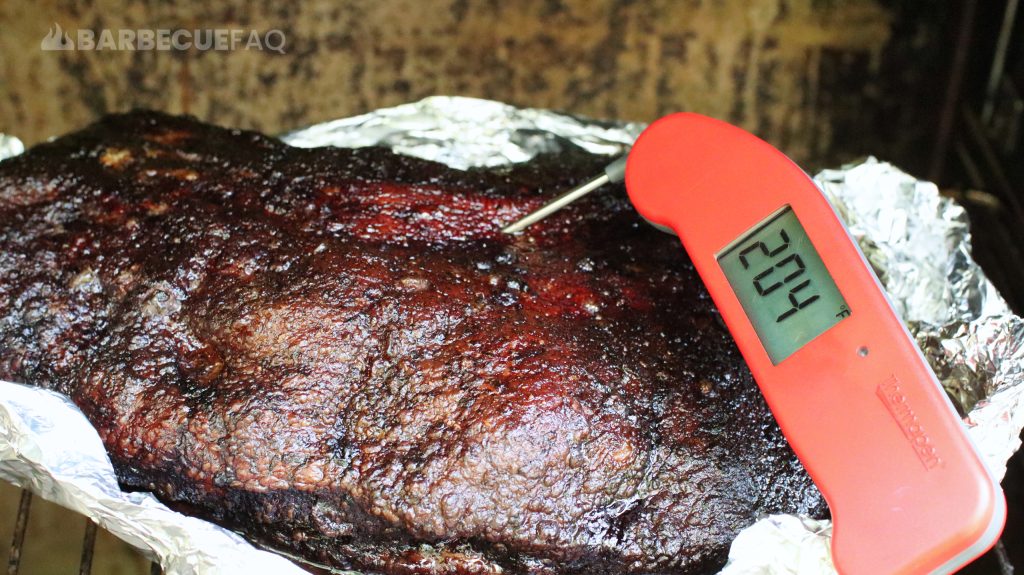
If You’re Holding Overnight
Smoke the brisket until the thickest part of the flat reaches 190F in the boat.
Once it reaches 190F, drop the temperature of your oven, smoker, or holding device to 175F*.
*This number is calibrated for my electric smoker. I know that 175F in my electric smoker will keep the internal temperature of my brisket above 140F for food safety.
Cover the top of the brisket with foil so it’s fully wrapped – this minimizes the exposure to air and slightly softens the bark and allows the meat to carry over cook as it rests overnight.
Then put it into the oven overnight for 12-16+ hours.
I find this method to be best – the meat is more tender, it’s juicier, the bark is still crunchy but slightly soft. Overall it’s truly a foolproof way to cook a good smoked brisket.
The next day, slice when it’s time to eat – no need to re-rest as you already just did that.
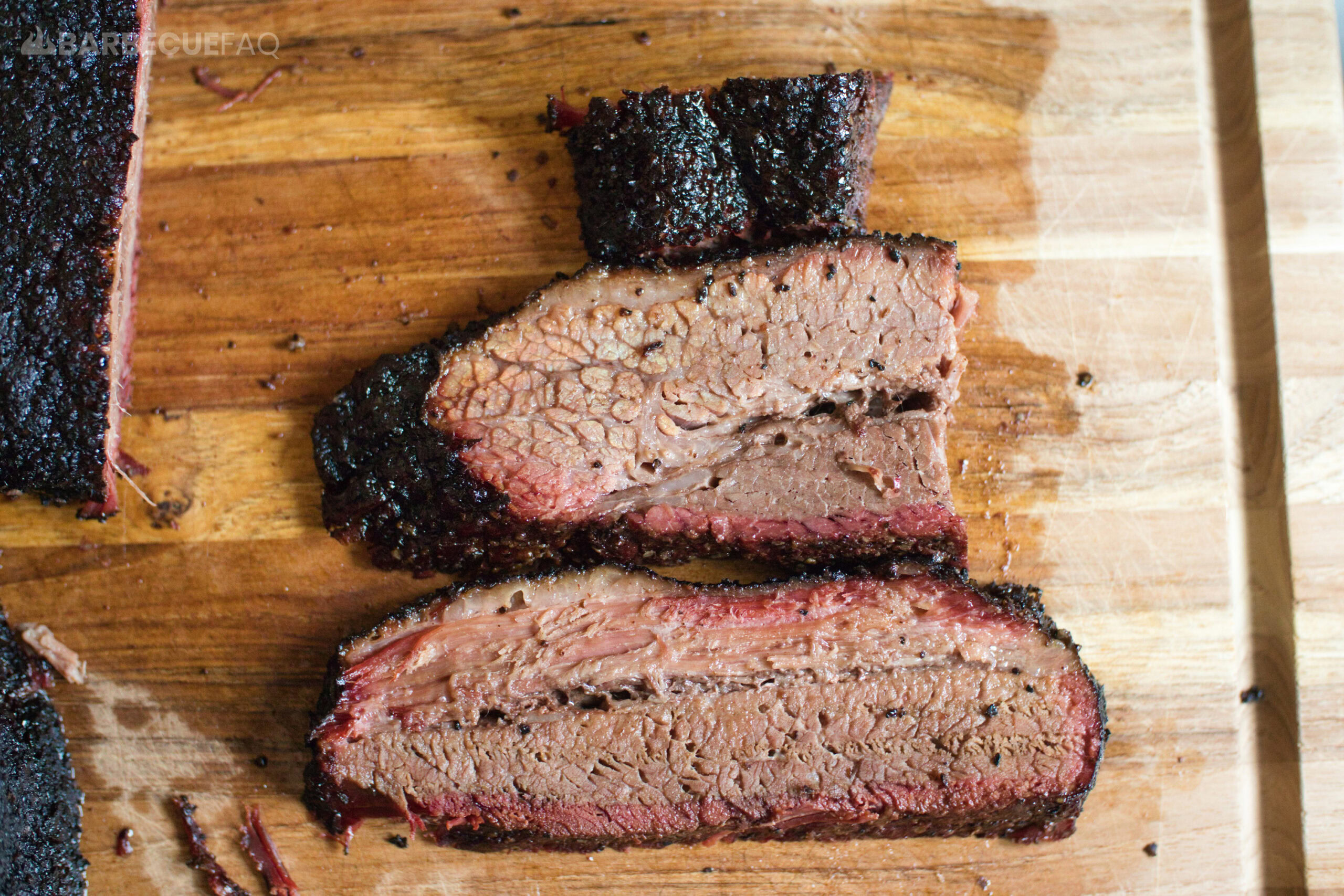
Foil Boat Brisket
Ingredients
- 10-13 lb Whole Brisket
Brisket Rub – Per Side, Apply in Layers
- 1 tbsp diamond crystal kosher salt
- 1 tbsp 16 mesh black pepper
- 1 tbsp seasoning salt like Lawry’s*
Instructions
- Trim brisket according to my guide linked above. Overall just remove hard fat that won't render, remove thin edges, and trim fat cap down to 1/4-1/2" thick
- Once trimmed, season each side in layers. Start with the salt, then the pepper, then the seasoned salt. Repeat this on the other side.1 tbsp diamond crystal kosher salt, 1 tbsp 16 mesh black pepper, 1 tbsp seasoning salt
- Get smoker to 225-250F.
- Put brisket on indirect with the fat side facing the heat source. On my weber kettle, that's fat side UP. Use your favorite hardwood. I used post-oak and added new wood every 45-60 minutes.
- Once the thickest part of the flat reaches ~170-180F, grab 2 sheets of aluminum foil (roughly an arms length.
- Put the brisket fat side up in the center of the foil and crumple around the edges of the brisket. Leave the fat cap exposed.
- Return to smoker or kitchen oven set to 250F.
From Here You have 2 Options
- 1. Smoke the brisket to complete probe tenderness (~195-205F) internal. Then rest on the counter or in your kitchen oven (while off) for 2 hours or until the internal temperature is 150-160F. Then slice and enjoy!
- 2. Cook the brisket until the internal temperature is 190F in the thickest part of the flat. Then transfer to your kitchen oven or smoker set to 175F without a rest. Cover the top of the boat with more foil so it's completely covered and then hold overnight for 12-16+ hours. The next day take out of the oven, slice, and enjoy!


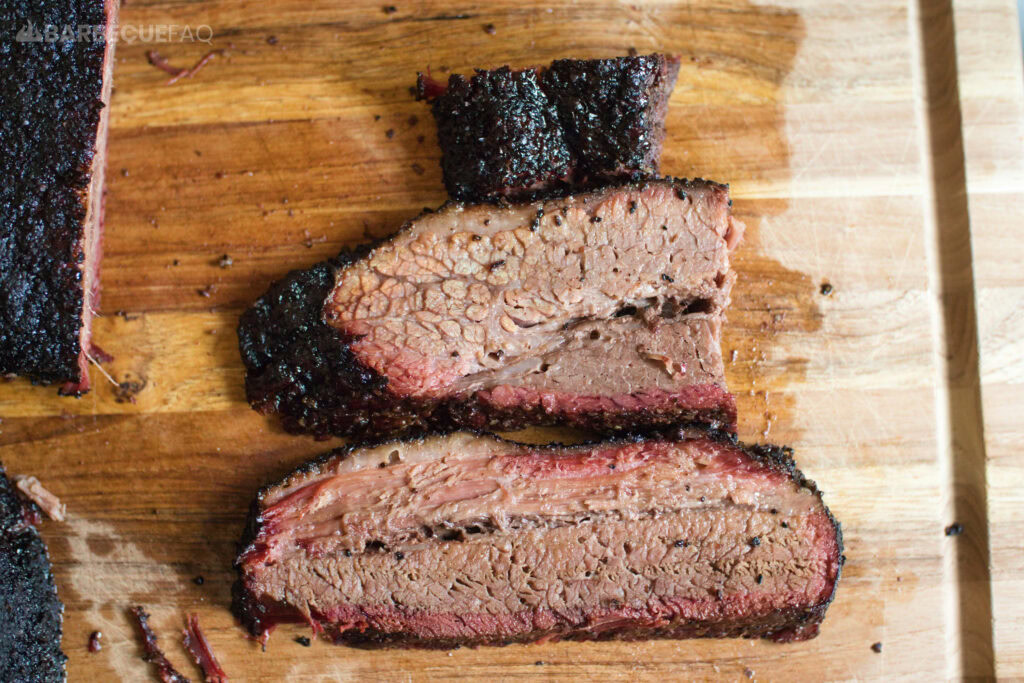


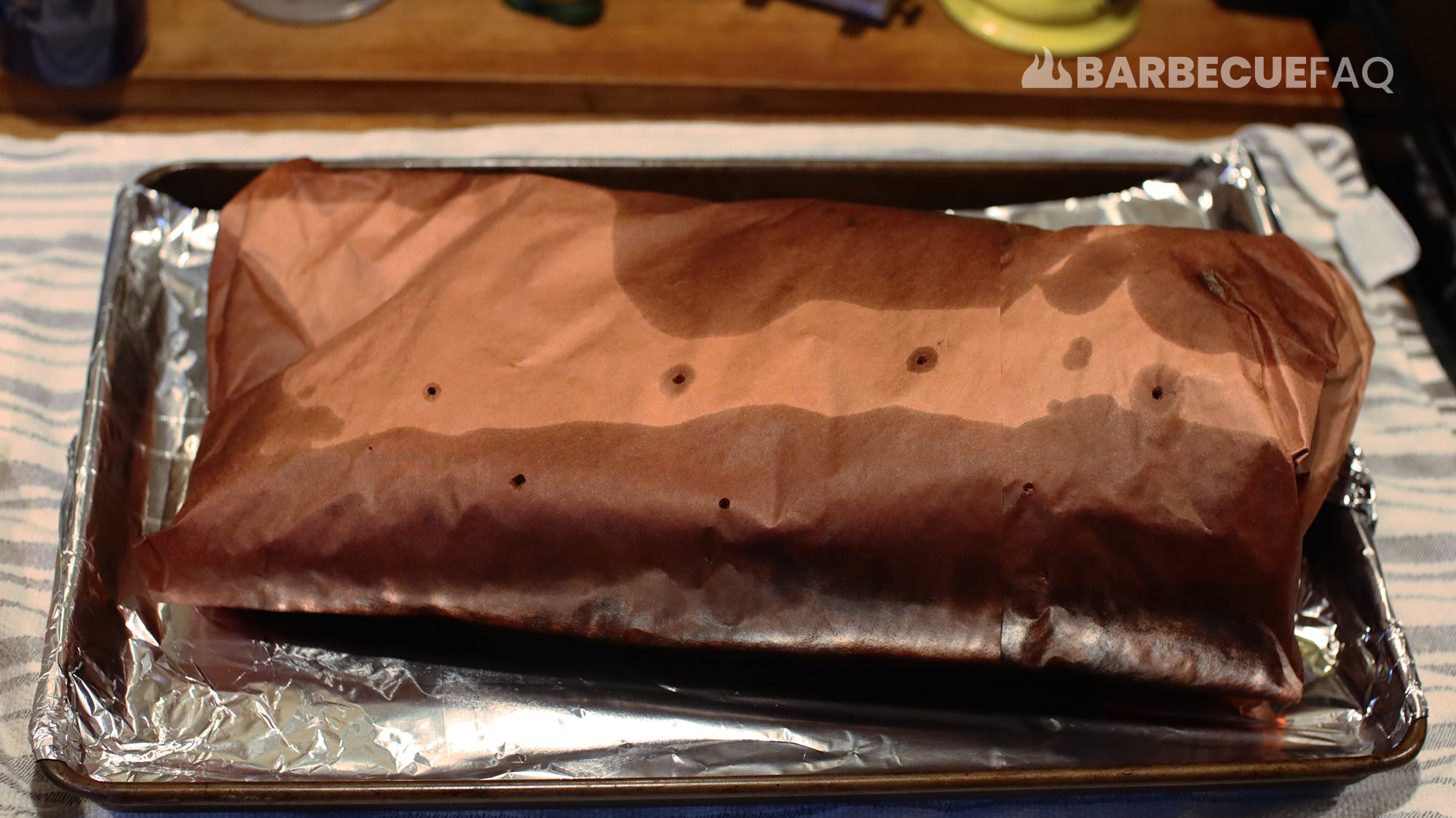
8 comments
Steven Berry
Truly the best explanation of how to get a great brisket no matter the method used. Using the same gear as you with a 26 Weber (needed more real estate) than the 22 offered. I foil boat at about 175 bark is what firm then and place in my Cook Shack electric smoker until 205. Remove to cool until 140 and hold for several hours until serving. This confirms what you have written.
Dylan Clay
Happy to help Steven!
I try to do my best to outline things the best way I can so that folks can put the information into action – so I’m glad to hear it was well received by you.
Gig Wyatt
Can I use those throwaway foil pans, available at most grocery stores? They come in various sizes, large enough for most brisket, and are fairly cheap.
Dylan Clay
Hey Gig,
Personally, I wouldn’t.
The foil boat keeps the wrap tight and cooks the meat side in the brisket’s own fat/juices and only exposes the outer fat layer. Where-as an aluminum pan exposes all parts of the brisket and likely wouldn’t render enough juices to “confit” the meat-side.
Covering up the aluminum pan would also result in condensation which would inevitably condense on the meat and soften the bark which is counter to the method. The whole point is to leave the fat side exposed so that it can continue to render and create a “crunchy” bark – which results in a pleasurable eating experience with contrasting textures.
Also – aluminum foil is MUCH cheaper by a long shot too. When looking at Walmart’s site (where I buy most of my materials) – 2 heavy duty sheet pans is $4.98 where-as 50 sq. ft. of heavy duty Reynolds wrap is $4.48; I’d take the latter any day of the week.
Bert
So when I do a Brisket I go fat side down, really I generally trim most fat off the point and leave 1/4″ on flat, so most briskets I do have fat on half the brisket. This is still a good method for me anyway right? Smoke on grate till internal of 155°-165° then put on couple sheets of foil make a boat around the brisket and continue till desired internal temp, correct?
Dylan Clay
Hey Bert!
So we sort of have conflicting opinions on trimming and when to wrap – which is cool as that’s one of the reasons I love barbecue. I’ll give you some insights and food for thought and maybe that’ll help.
To start, the foil boat method is ALL about fat render and the bark; Those are the main advantages and your goal is to essentially maximize bark and maintain the crunchy exterior.
In terms of fat cap orientation when foil boating, I’d always recommend folks start with the fat cap up, simply for presentation purposes.
The goal initially is to set the bark and to avoid things like grill marks or carbonized debris on your presentation side. The foil boat is also used because it focuses on bark – most notably a “crunchy” exterior bark. To promote a better bark, the fat is left on because it holds onto the pepper better than the lean meat – that’s just my experience.
Starting fat cap down will likely result in a markedly less “set-up” bark. Even in the case of flipping a brisket mid-cook, you’re apt to lose some bark when you go to foil boat it.
Just to illustrate:
With pellet grills, your heat source is below the meat; Initially, I’d start fat cap up to set the bark. After 2 hours or so, I’d flip the brisket so that the heat can start rendering the fat cap. Meaning your fat cap is then down. I then foil boat when I’m happy with the bark – something I always tell folks to do is to wait further into their stalls; Personally, I foil boat at around 170-175F, mainly because your bark improves and so does your fat render; Smoke is attracted to wet surfaces and at 155-165F, you’re still pushing out tons of moisture (which is why a stall happens in the first place).
At that point, I foil boat with the fat cap facing up so that it can continue to render. The meat side of the brisket will then confit in its own juices which will soften the underside of the brisket (the meat side).
In the case of pellet grills, I’d even suggest placing the foil boated brisket to the right of the burn pot so that the heat rolls over your meat and out the smokestack.
Hopefully that answers your question to some extent!
Randy Serven
Thank you for taking the time. This is so helpful to someone who is new to smoking.
Dylan Clay
No problem Randy, I’m happy to help!